|
|
|
Sort Order |
|
|
|
Items / Page
|
|
|
|
|
|
|
| Srl | Item |
| 1 |
ID:
113019
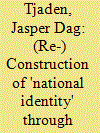

|
|
|
|
|
| Publication |
2012.
|
| Summary/Abstract |
Social constructivist theories regard the nation as 'imagined' (Anderson), 'invented' (Hobsbawm and Ranger), and 'narrated' (Bhabha). National narratives use mass rituals, performances, and selective national history to reinvigorate collective identity. This article examines the 1910 centennial festivities in Chile as a collective and discursive quest for national identity in a changing society longing for stability. The article uses a discourse analysis approach to study a series of Chilean national history abstracts and coverage of the centennial festivities as presented in Zig-Zag, the most relevant political magazine at the time. The study finds that selective memory and mass ritual discourse are a constitutive part of national identity. Through the process of selective memory, the sources depict Chilean history as a series of linear, coherent, and meaningful events to foster collective identification with the nation. The images of mass ritual discourse of the centennial celebrations reinforce common national characteristics and confidence in the nation. Mass performances provide emotional self-affirmation and an endowment of meaning for individuals within their national group as they restage current national membership with reference to a common past. The study identifies themes of national representation along which the nation is narrated, and suggests that this typology can be generalised beyond the case of Chile. In doing so, this article underscores the need for further research on the concept of discursive national identity formation and its relevance in contemporary politics.
|
|
|
|
|
|
|
|
|
|
|
|
|
|
|
|
| 2 |
ID:
113021
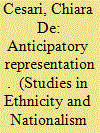

|
|
|
|
|
| Publication |
2012.
|
| Summary/Abstract |
This article aims to illuminate the ways in which artists and cultural producers can participate in forging the nation(-state) by performing its institutions, and by mocking its operations. It explores two experiments in setting up a Palestinian national museum, which are also art projects in themselves. It also discusses the recent Palestinian art biennials, organised by a Palestinian non-governmental organisation in 2007 and 2009 in various locations across the Mediterranean. It is my argument that the experiments with the Palestinian national museum and the biennials constitute a kind of artistic practice that does not just represent or imitate the social world: they are artistic practices that purport to produce new social arrangements - in particular, a set of new 'state' (art and cultural) institutions under conditions of statelessness. I also discuss how such a tactic of anticipatory representation, which calls into being, by representing them beforehand, institutions that do not yet (fully) exist, bears resemblance with recent policies adopted by the Palestinian political establishment.
|
|
|
|
|
|
|
|
|
|
|
|
|
|
|
|
| 3 |
ID:
113027
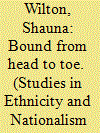

|
|
|
|
|
| Publication |
2012.
|
| Summary/Abstract |
This article explores the clothing choices of Indian women and the relationship between clothing and the construction of the nation in contemporary India. Building on the existing literature on nationalism, combined with feminist and cultural studies approaches, the article uses interviews with young Indian women as an entry point into exploring the symbolic role of women and the sari within Indian nationalism. In doing so, this article questions to what extent choosing what to wear is an example of choosing the nation, whether it is a free and conscious choice, and whether it is appropriate to see these choices as constitutive of national identity or merely ornamental. In conclusion, I argue that something as ordinary as choosing what to wear has the potential to undermine dominant discourses surrounding the nation. While choosing to wear the sari does not always reflect a conscious choosing of the Indian nation, the clothing choices of Indian women do allow them to navigate complex social and cultural identities in their everyday lives and reflect the importance of the 'everyday' within theorising and explaining the construction and maintenance of nations.
|
|
|
|
|
|
|
|
|
|
|
|
|
|
|
|
| 4 |
ID:
113014
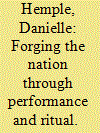

|
|
|
| 5 |
ID:
113017
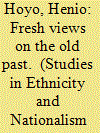

|
|
|
|
|
| Publication |
2012.
|
| Summary/Abstract |
The year 2010 in Mexico marked both the 200th anniversary of the start of its independence movement and the 100th anniversary of its revolution. Besides several public events, a number of items including commemorative coins, banknotes, and stamps were produced to mark the occasion. This article analyses the postage stamps issued to commemorate the Mexican bicentennial. It does so by comparing these stamps with the ones issued for previous independence anniversaries, and then tracking changes and continuities in their messages. It is found that, on the one hand, the bicentennial postage stamps of Mexico promoted a particular narrative regarding the historical, territorial, and ethnic features of the Mexican independence process, which in many ways departs from previous, long-established nationalist narratives. But on the other hand, bicentennial stamps also demonstrate the influence of traditional interpretations of the national past - particularly those related to the Partido Revolucionario Institucional's (Institutional Revolutionary Party, PRI) revolutionary nationalism doctrine - which are still being reproduced even after the 2000 democratic transition.
|
|
|
|
|
|
|
|
|
|
|
|
|
|
|
|
| 6 |
ID:
113026
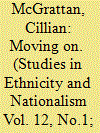

|
|
|
|
|
| Publication |
2012.
|
| Summary/Abstract |
Debates over the direction of the Northern Irish peace process have moved from decommissioning and all-party inclusion to community relations and whether society is becoming more or less integrated and shared. This article contends that what is missing from this debate is consideration of the fact that a process of de-politicisation is occurring - specifically, inspired by a progressivist imperative, political discourse and engagement are increasingly moving from the public sphere to more privatised concerns. I argue that that vision does not speak to the trauma of the past and that the silencings, limitations, and dilemmas it leads to are most lucidly seen in recent Northern Irish drama productions. I conclude by sketching an alternative ethical vision based on an attachment to remembering historical injustices and a repudiation of the social pressure to draw a line under the past.
|
|
|
|
|
|
|
|
|
|
|
|
|
|
|
|
| 7 |
ID:
113022
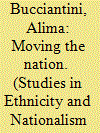

|
|
|
|
|
| Publication |
2012.
|
| Summary/Abstract |
Temporary exhibitions in national museums provide a window into the ways in which national identity is performed. When one national museum is presented in the space of another nation, the changes of narrative and performance are even more vivid. Looking at a 1984 exhibition of American artefacts in Scotland, Treasures from the Smithsonian Institution at the Royal Scottish Museum, this article examines how material culture can hold ever-changing narratives of nation and identity, and how they alter to suit new contexts and spaces.
|
|
|
|
|
|
|
|
|
|
|
|
|
|
|
|
| 8 |
ID:
113024
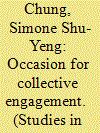

|
|
|
|
|
| Publication |
2012.
|
| Summary/Abstract |
The article discusses how the intertextual relationship between film, performing arts, literature, and the liberal capitalist structure of the Malay film studio system was exploited by British colonialists and Malay intellectuals alike to encourage the formation of nationalistic aspirations in the 1950s and 1960s. Although Malay epics were seen to portray a particularly Malay-centric view of feudal societies, they imply a wider political objective when the production histories of three epic films - the legend of Hang Tuah (1956), his nemesis Hang Jebat (1961), and the folktale Raja Bersiong (1968) - are reviewed. Malaysia's first Prime Minister's incorporation of plays in his political campaigns and forays into film suggests his belief that the media could be instrumental in projecting an indigenised national identity. Created for a wide cinematic audience, such films encouraged cinemas' function as the space of convergence where members of Malaysia's plural society could participate in the undifferentiated cinematic experience.
|
|
|
|
|
|
|
|
|
|
|
|
|
|
|
|
| 9 |
ID:
113016


|
|
|
|
|
| Publication |
2012.
|
| Summary/Abstract |
The sixtieth anniversary of the founding of the People's Republic of China on 1 October 2009 was marked with a massive parade in the heart of Beijing viewed on hundreds of millions of television screens across the nation. English-language media coverage focused primarily on what it saw as the event's explicit message: the Communist Party's celebration of the nation's military might and continued economic growth, and its origins in a coherent and uniquely Chinese ideology. Such coverage largely reflected international fears of China and thus misread the parade's import and impact on its domestic audience. I argue that the National Day events are better understood as a form of visual poetry that relied on performance to emotionally conflate party, nation, and state. Both the speeches of party leaders and the scripted remarks of state media commentators relied on language and ideas that the Chinese public has heard numerous times. The visual elements of the parade, in contrast, were unprecedented in both scale and spectacle. Hundreds of thousands took part in displays of collective harmony, unified patriotic sentiment, and ethnic unity. The distinctive style and rhythm of the parade depicted a vision of nationhood without the ethnic fractures, labour unrest, and massive inequalities that constitute the greatest threat to the power of the party-state as it embarks on its seventh decade of continuous rule.
|
|
|
|
|
|
|
|
|
|
|
|
|
|
|
|
| 10 |
ID:
113020


|
|
|
|
|
| Publication |
2012.
|
| Summary/Abstract |
This article analyses recent attempts of Roma/Gypsy organisations to construct a pan-Romani ethnic-national identity. It is argued that although Roma do not fit the classical picture of a nation, in the globalised world such a project of transnational or diasporic identity may be viable in spite of the fragmentation of Romani communities. The article presents two groups of rituals employed by the Romani political movement: linguistic rituals, associated with the attempt to introduce an umbrella concept of 'Roma', and rituals of remembrance, which 'authenticate' certain streams of Romani history to introduce among Roma a sense of a common past. The article concludes that the ritual approach may be an efficient method to study the project of Romani national identity. With functions similar to religious ritual, Romani political rituals form a bridge between empirical Roma identity and the projected national identity, although in other contexts there may be little communication between them.
|
|
|
|
|
|
|
|
|
|
|
|
|
|
|
|
| 11 |
ID:
113023
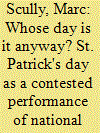

|
|
|
|
|
| Publication |
2012.
|
| Summary/Abstract |
One of the more intriguing aspects of St. Patrick's Day celebrations as a nationalised ritual of a performed Irishness, both within and outside Ireland, is the extent to which it represents a dialogue between territorialised and diasporic expressions of Irish identity, and claims of belonging to Irishness. St. Patrick's Day celebrations in English cities are a particularly intriguing example of this contestation, due to the proximity of the two countries and the historical structural and cultural constraints on the public performance of Irish identity in England, as well as their more recent reinvention within celebratory multiculturalism. This article examines how debates around the authenticity of St. Patrick's Day parades in English cities are employed in the identity work of individual Irish people. In doing so, it provides insight on the tensions between Irishness as transnational, diasporic, and ethnic, as experienced in England.
|
|
|
|
|
|
|
|
|
|
|
|
|
|
|
|
| 12 |
ID:
113028
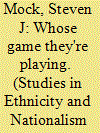

|
|
|
|
|
| Publication |
2012.
|
| Summary/Abstract |
Through the examination of four commercials advertising products by transnational corporations broadcast to Canadian audiences during coverage of the 2010 Winter Olympics in Vancouver, this article explores how certain images, particularly those related to hockey, appeal to emotion through the conduit of national identity. Drawing out recurring symbols and themes, I demonstrate that it is not one's love of hockey in itself, or the excitement one feels watching hockey to which these commercials appeal. Rather, hockey serves in these commercials as a national 'totem', an empty signifier like a flag whose primary meaning lies in its status as emblem of the group, recognised in common by members of the group as encapsulating and organising the otherwise heterogeneous assortment of myths, symbols, and values that constitute group identity. What these commercials do, intentionally or not, is re-enact a ritual of almost religious function in which the national group reaffirms its agreement to be a group by unanimously experiencing the same emotion over the same object. The success of the advertisement rests in the ability of the advertiser to incorporate the product as a participant in the ritual; as a vital ingredient to the successful completion of the ritual, if not as an honorary non-human member of the group itself.
|
|
|
|
|
|
|
|
|
|
|
|
|
|
|
|
| 13 |
ID:
113025
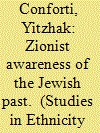

|
|
|
|
|
| Publication |
2012.
|
| Summary/Abstract |
Since the 1980s, the question of how nations are formed has been the topic of historiographic debate: is it correct to define nation-building in terms of inventing traditions, or is the ethnic-symbolic viewpoint more useful in understanding the process of development of the nation-state? This debate is also reflected in research on Jewish nationalism. In this article, I will examine this issue in relation to the Zionist movement, focusing on several clear examples of forging the nation and nation-building: 1) the change in configuration of traditional Jewish holidays; 2) ceremonies and Zionist holidays on kibbutzim; 3) the status of the Bible in the Zionist movement; and 4) Jewish history and Zionist historiography. These examples indicate that the process of nation-building reveals a strong ethnic-cultural link to the Jewish past. I will argue that modern political explanations such as inventing tradition do not offer a full explanation of the phenomenon of Jewish nationalism. In order to arrive at a comprehensive understanding of the success of Zionism in consolidating around it a group willing to commit such a high level of personal sacrifice over time, we must give consideration to cultural-ethnic continuity as well as the feeling of commitment and sanctity that Jewish nationalism offered to its believers, both religious and secular.
|
|
|
|
|
|
|
|
|
|
|
|
|
|
|
|
|
|
|
|
|